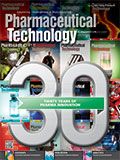Regulatory Harmony
Pharmaceutical Technology Europe
Harmonization of regulatory guidelines not only reduces workloads for manufacturers and regulators but can potentially help to accelerate patient access to vital therapies.
In highly regulated industries, such as pharma, compliance and adherence to good manufacturing practices (GMPs) are essential to ensure basic product safety, efficacy, and quality. To learn more about the changes in GMP and regulations in pharma over the past few decades, as well as how harmonizing approaches is beneficial to the industry, Pharmaceutical Technology Europe spoke with Afshin Hosseiny, chairman of the ECA Foundation.
Biggest changes
PTE: Reviewing the past few decades, what have been the biggest changes in GMP and regulatory guidelines?
Hosseiny (ECA Foundation): Pharmaceutical manufacturing and product testing have gone through major changes over the past 30 years due to the introduction of new products as well as technological advances in manufacturing and automation. These advances in product and technology have driven changes in the regulations, ensuring that adequate controls remain in place whilst maintaining the basic GMP expectations of product safety, efficacy, and quality.
The European Medicines Agency (EMA) was established in 1995 with the main objective of harmonizing the existing national medicines regulatory bodies across the European Union. The introduction of the EU GMP guidelines for human medicines was a major step forward in establishing common GMP requirements across the EU. Since then, we have seen changes in these requirements to allow regulation to remain in line with the technological advances introduced by the manufacturers.
Publication of the EU GMP Part II for APIs was a major challenge for the manufacturers of APIs, as historically, they were treated as chemicals with little or no GMP perspective during manufacturing and supply. The GMP for APIs, followed by clarification of the role of qualified persons (QPs) in relation to the GMP compliance of APIs for use in the manufacture of medicines, created additional challenges for QPs.
Other major changes in the regulations included approaches and controls required for sterile manufacturing processes, the application of GMP to computerized systems, and, most recently, the management of the pharmaceutical products’ supply chain, ensuring product integrity from manufacturer to the final customer. ECA, through its various working groups, has been involved in reviewing, commenting, and preparing implementation guidelines for the industry for the past 20 years, ensuring a harmonized approach to implementation of the new regulations.
Benefits of a harmonized approach
PTE: What are the benefits of harmonizing approaches to GMP and regulatory guidance and what work is being done to progress regulatory harmonization?
Hosseiny (ECA Foundation): The EU has been developed to facilitate open borders with free movement of products and people. Medicinal products manufactured and released by a QP in one member state can be sold in any of the 28 member states across the EU. To facilitate this, we have to ensure everybody operates to the same standard; therefore, harmonization of the regulations and their application and controls are critical in achieving the EU objective.
Over the past 20 years, ECA has played a major role in this task by providing a bridge between the industry and the regulators, developing interpretation documents, participating in joint meetings to improve the industry personnel’s understanding of the regulations and the regulator’s understanding of the challenges manufacturers have to overcome when producing medicines for supply. The harmonization has also helped to reduce workload for manufacturers as well as regulators, allowing them to move the focus of their attention to the more critical areas of GMP.
A recent benefit of harmonization is the mutual recognition agreement between the EMA and the US Food and Drug Administration, creating a substantial benefit by reducing the number of inspections performed by both the regulators and industry, which will avoid duplicate inspections.
Looking to the future
PTE: Are there specific regulations the industry should expect to be introduced in the near future?
Hosseiny (ECA Foundation): Introduction of new and complex products will force the development of new regulations. Undoubtedly, there will be new regulations for the development and manufacture of advanced therapy medicinal products (ATMPs), further development of guidelines on data governance, and of course the finalization of the Annex 1 (manufacture of sterile products), all of which will pose major challenges to the pharma industry. We anticipate additional product development requirements for the application of quality management principles to product development through to final commercial supply becoming a major focus point for the regulators.
ECA will continue to progress through its working groups in influencing the development of these regulations, ensuring a harmonized approach across the industry. Our working groups are currently actively involved in providing input to the Annex 1 guidelines. In addition, our newly established groups, such as the ATMP group and the Cannabis Based Medicines group, will be working across the industry and the regulators to ensure adequate harmonized GMP regulations for these medicines which are to be developed in the near future.
Article Details
Pharmaceutical Technology Europe
Vol. 31, No. 8
July 2019
Page: 30
Citation
When referring to this article, please cite it as F. Thomas, “Regulatory Harmony,” Pharmaceutical Technology Europe 31 (8) 2019.

PacBio Chosen as Tech Partner for Global Alzheimer’s Disease Research Project
April 23rd 2025The project, the North African Dementia Registry, will unite multiple entities for the purpose of developing a comprehensive dataset to advance the research community’s understanding of Alzheimer’s disease and other dementias in diverse populations.